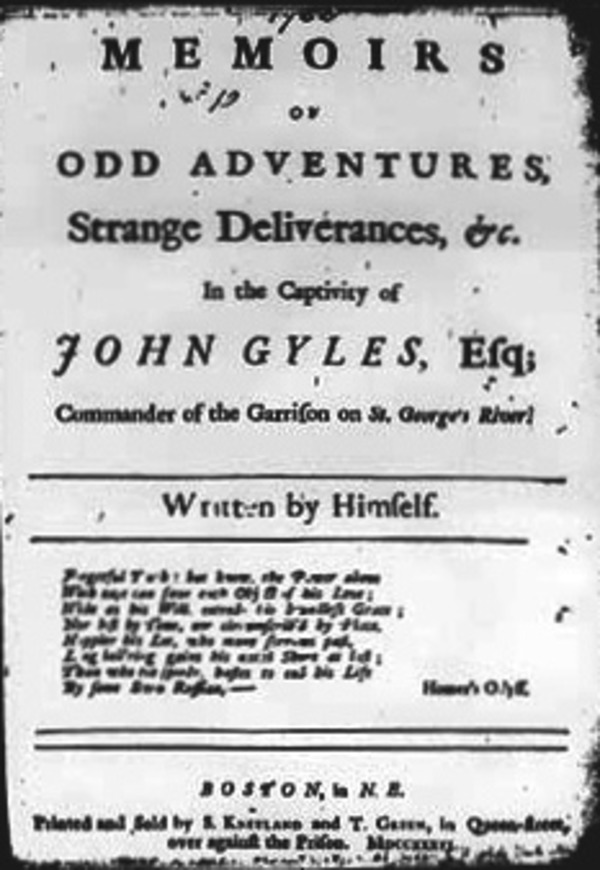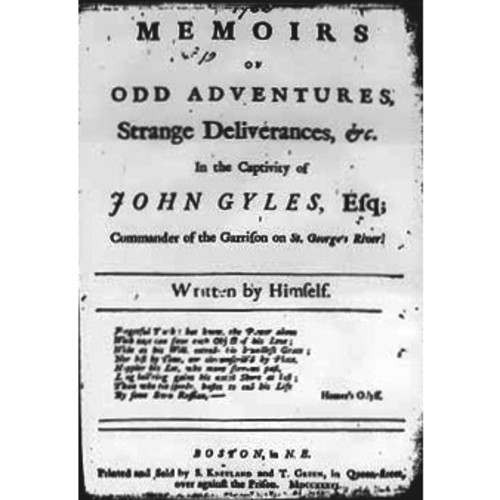
Source: Courtesy of Wikimedia Commons
GYLES, JOHN, interpreter, soldier; b. c. 1680 at Pemaquid (Me.); m. Ruth True (1703) and Hannah Heath (1722); d. at Roxbury (now part of Boston, Mass.), 1755. It is not known how many children he had.
John Gyles is the author of the most authentic and remarkable account in English of the Malecites (Etchemins) of the Saint John River. In 1689, when he was nine years of age, he was living with his family at Fort Charles (Pemaquid). On 2 August of that year (o.s.), while labouring with his father Thomas in the vicinity of the new fort, he was taken prisoner by Malecites in one of the bloody forays that characterized the period. John’s father was killed, one brother was captured and later killed, and another brother escaped. John was conveyed up the Penobscot River, across portages to the Chiputneticook Lakes, and on to the confluence of the Médoctec (Eel) River with the Saint John, ten miles below present-day Woodstock, N.B.
For six years Gyles was slave to the Malecites. His graphic story of his adventures describes the customs of the Malecites, their techniques in the chase, their social order, the tortures inflicted on captives, and the impact made on them by the relatively few French on the Saint John before 1700. The account gives a striking impression of the extremities endured by the Malecites in good and bad times, their gluttony when rewarded by hunting, and their misery in the winter season when game was scarce. They could live only by dispersal from the fort at Médoctec (Meductic), where they were ministered to by the Recollet priest Simon Girard* de La Place. John Gyles was forced to serve as drudge to one of the many small hunting parties which moved as far north as Gaspésie. Starvation for seven or eight days on end was not unusual.
His fortunes greatly improved in the summer of 1695 when he was sold to Louis Damours* de Chauffours, who had a seigneury at Jemseg. John hunted and traded for Damours and worked in his store. In October 1696 English invaders came up the Saint John River to attack Governor Joseph Robinau* de Villebon’s fort at the Naxouat (Nashwaak) River. Damours was in France at the time, but Gyles helped to save his master’s house from destruction. He posted on the door a statement, written by Damours’s wife, that English captives had been treated kindly there. After the peace of Ryswick Gyles was delivered to the captain of an English vessel at the mouth of the Saint John and sailed for Boston, where he arrived on 19 June 1698. His account of the French inhabitants of the Saint John is sympathetic.
Gyles’ facility in the Indian dialects of Acadia made him invaluable to the governing authorities of New England when war broke out again in 1701. He served as an interpreter under many flags of truce, sailed with Major Benjamin Church* in 1704, and fought with Colonel John March* at Port-Royal (Annapolis Royal, N.S.) in 1707. Most of his later life was given to military service and to liaison with the Indians. In 1715 he helped construct Fort George at Pejepscot (Brunswick, Me.); he remained to command the fort until 1725. He finished his military career as commander of the New England garrison on the St George’s River.
In 1736 Gyles published his memoirs of his adventures. He said that he had collected them from his “minutes” some years before, at the request of his second wife, Hannah, “for the use of our family, that we might have a memento ever ready at hand, to excite in ourselves gratitude and thankfulness to God.” When the memoirs were read by some of his friends, Gyles was “pressed for a copy for the public.”
Gyles’ account of his captivity is entitled Memoirs of odd adventures, strange deliverances, etc. in the captivity of John Gyles, esq., commander of the garrison on Saint George River, in the district of Maine. First printed in Boston in 1736, it was reprinted in S. G. Drake, Indian captivities, or life in the wigwam (Buffalo, 1853), 73–108, and, as a separate volume, in Cincinnati (1869) and Saint John, N.B. (1875). For a “semi-fictional” account, see Stuart Trueman, The ordeal of John Gyles . . . (Toronto, [1961).
Documentary history of Maine, IX, X, XXIII–XXIV. “Indian treaties,” Maine Hist. Soc. Coll., 1st ser., III (1853), 362, 381, 420. “John Gyles’s statement of the number of Indians,” Maine Hist. Soc. Coll., 1st ser., III (1853), 356–57. Coleman, New England captives. J. A. Vinton, Thomas Gyles and his neighbors, 1669–1689 . . . (Boston, 1867). John McKeen, “Some account of the early settlements at Sagadahock and on the Androscoggin River . . . ,” Maine Hist. Soc. Coll., 1st ser., III (1853), 314–15.
Cite This Article
W. S. MacNutt, “GYLES, JOHN,” in Dictionary of Canadian Biography, vol. 3, University of Toronto/Université Laval, 2003–, accessed January 8, 2026, https://www.biographi.ca/en/bio/gyles_john_3E.html.
The citation above shows the format for footnotes and endnotes according to the Chicago manual of style (16th edition). Information to be used in other citation formats:
| Permalink: | https://www.biographi.ca/en/bio/gyles_john_3E.html |
| Author of Article: | W. S. MacNutt |
| Title of Article: | GYLES, JOHN |
| Publication Name: | Dictionary of Canadian Biography, vol. 3 |
| Publisher: | University of Toronto/Université Laval |
| Year of publication: | 1974 |
| Year of revision: | 1974 |
| Access Date: | January 8, 2026 |



